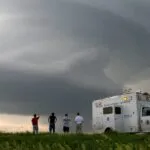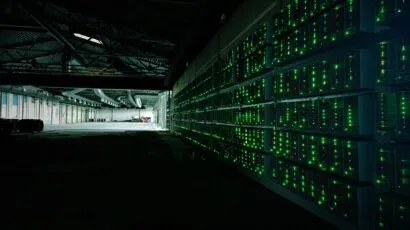Does going “off the grid” actually help the climate?
By Dawn Stover | April 9, 2015
On February 11, CEO Elon Musk of Tesla Motors said that his company would soon be unveiling plans for a battery that could power your home, and that production could begin as early as August. The kind of in-house energy storage he is proposing could help make renewables a bigger part of the global supply. But headlines announcing that a Tesla battery “could take your home off the grid” spread misconceptions about what it takes to be self-sufficient—and stop global warming.
If you’re an average American, you can’t go “off the grid” simply by mounting a few solar panels on your roof, installing a battery in your basement, and plugging your car into an electrical outlet to refuel it. That is like calling yourself a vegetarian even though you eat chicken or fish when it suits you.
Truly going off the grid usually means a commitment to using far less energy than most Americans: for example, purchasing extremely efficient appliances, scheduling energy usage, and living without a beer fridge or big-screen television or clothes dryer. Taking personal steps to conserve energy is commendable. But placing the responsibility for climate action on individuals, and encouraging an every-man-for-himself approach, may actually work against some energy solutions and do little to reduce overall greenhouse gas emissions.
No compromises. While a Tesla home battery might appeal to someone living modestly in a remote cabin, it’s more likely to be purchased by a person like Jason Hughes, a day trader who apparently couldn’t wait for the off-the-shelf version. Hughes is spending $20,000 and countless hours to convert a Tesla car battery into an energy storage system for his home.
He would probably fit in better at a “prepper” convention—a meeting of survivalists getting ready for disaster—than at the Paris climate talks later this year. Responding to questions about the YouTube video of his battery hack, Hughes wrote: “My goal is to basically have a Tesla-style ‘no compromises’ off-grid setup…thus a power hungry one.”
Some people just like the idea of being off the grid and don’t mind paying extra for it. It has a certain prestige, the way that driving a Tesla S makes you stand out in a crowd. A Tesla home battery will probably make its owner feel more invincible than and superior to a neighbor with a generator in his garage.
The price for the Tesla battery hasn’t been announced yet. But if it’s anything like the Tesla S car, which has a price tag ranging from $71,070 to $105,670, it will be a luxury item. Even if everyone could afford one, it’s not clear where the lithium and other raw materials for all those batteries would come from.
No man is an island. Home batteries may be great for power outages, but it’s unclear whether they will do much to mitigate global warming. In fact, they could undermine large-scale efforts to combat climate change, by isolating energy production and usage rather than sharing it efficiently within a network.
While Tesla owners, especially those who generate their own solar power, might have the greenest of intentions, they live in a virtual gated community that excludes most of humanity. And by focusing their considerable resources on individual empowerment rather than on systemic issues, they make global warming a matter of consumer choice rather than of political mobilization and community involvement. Markus Giesler, an associate professor of marketing at York University in Toronto, writing about how the World Economic Forum has shifted the burden for solving global warming and other problems away from government and business, calls this phenomenon “consumer responsibilization.”
Just as the “crying Indian” anti-littering ad of the 1970s implied that pollution was the fault of individuals rather than corporations, Tesla seems to be suggesting that the climate crisis is something Americans should solve on their own rather than calling fossil fuel companies to account, or pressing elected officials about why the Energy Department’s fiscal year 2016 budget request would spend only $2.7 billion on energy efficiency and renewables—but a whopping $18.9 billion on nuclear defense activities.
The solar revolution. It’s great that California and a few other states are now generating a significant percentage of their electricity from solar power. But most of the growth in California has come from a handful of utility-scale projects, which together have more than twice the capacity of the almost 250,000 solar projects installed on homes and businesses.
While distributed energy generation has some distinct advantages—it eliminates transmission inefficiencies and doesn’t require sacrificing huge tracts of wilderness to energy industrialization—individuals alone cannot solve the massive problem of climate change. Especially if they are individuals like Jason Hughes, who envision going “off the grid” without dramatically reducing their energy consumption.
Few homeowners and businesspeople would be interested in installing solar systems if most states did not require “net metering,” which allows a customer’s electricity meter to run backward as well as forward: You can sell electricity to the local utility when you produce more than you need, and buy it when you run short. In effect, the grid acts like a giant battery—one that you don’t have to purchase or maintain. You just have to stay on the grid.
A utility “death spiral”? Net metering encourages consumers to make their own electricity, which is a good thing because it reduces the amount of electricity that must be generated elsewhere, but it is not without complications. As renewable energy production increases, utilities are complaining that they should not have to bear all the costs of backing up intermittent solar and wind power with steadier energy sources: hydropower, nuclear, coal, and natural gas. Turning conventional power plants on and off to match the variability of the sun or wind cuts into efficiency and increases greenhouse gas emissions, undermining the raison d’etre of renewables.
The utilities argue that renewable energy producers who want to sell electricity to the grid should help pay for backup power. Otherwise, that cost falls on a shrinking base of customers, forcing the utility to raise prices. Residential and business customers may then begin defecting in even larger numbers, raising the specter of a so-called “utility death spiral.” That isn’t likely to happen anytime soon, but utilities do need to update their business models with better provisions for load balancing and renewable energy storage.
If the future owners of Tesla home batteries remain on the grid, for example, utilities could pay them to store energy for others as well as for themselves. Teslas and other electric cars, parked at homes or businesses during most hours, could also become part of the grid’s giant “battery.”
Distributed energy storage. Some automobile manufacturers are already experimenting with using cars for energy storage. Nissan is currently testing a “Leaf to Home” system that would allow the battery in a Leaf car to power an average Japanese household (which uses about one-third the electricity of an American household) for about two days. Toyota has announced that it will start selling the Mirai, a hydrogen fuel cell car with a battery that can reportedly power a Japanese home for up to a week when fully charged, in California. And Honda has designed an experimental house that can be powered by an electric car parked in its garage.
None of these projects is intended for homes that are off the grid. They are primarily designed to help owners handle power outages. But why not use them to tackle the climate emergency?
With a smarter grid, excess electricity generated by solar panels and wind turbines could be distributed to a network of on-the-grid home and car batteries. Some utilities have also experimented with using home water heaters as an economical substitute for batteries: turning them on by remote control to store excess power (in the form of heat), or off to relieve loads when the grid is experiencing heavy demand (while still providing hot water when customers need it).
Like car batteries, home water heaters are dormant for most of the day. It makes more sense, and costs less, to put this existing infrastructure to work than to build huge new energy storage facilities. But it’s not yet clear whether a network of smart water heaters, batteries, and other devices would be economical and efficient. Conserving energy is always a cheaper option than building or expanding energy infrastructure.
Americans are experts at wasting infrastructure, though: Just look at all the cars sitting idle in driveways and parking lots, and all the traffic jams caused by five-passenger vehicles with only one person in each of them. Purchasing expensive batteries only to reserve them for occasional emergency use, or to hoard electricity for a no-compromises lifestyle, would be another case study in wastefulness. Small solar systems with battery backups are a good solution for the world’s 1.3 billion people who have no electricity, and Musk is an investor in one such enterprise in Tanzania. But Americans need to concern themselves more with conservation and global climate solutions than with the fantasy of achieving self-sufficiency through consumerism.
Together, we make the world safer.
The Bulletin elevates expert voices above the noise. But as an independent nonprofit organization, our operations depend on the support of readers like you. Help us continue to deliver quality journalism that holds leaders accountable. Your support of our work at any level is important. In return, we promise our coverage will be understandable, influential, vigilant, solution-oriented, and fair-minded. Together we can make a difference.
Topics: Climate Change, Columnists















